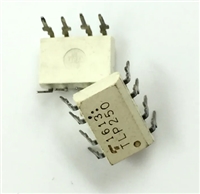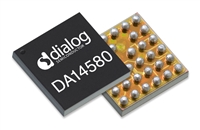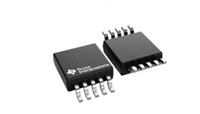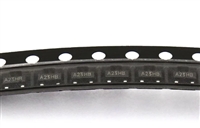pulse is 80ns. To recover to 0.1% requires 860ns. This rapid
recovery is due to the wide bandwidth of the output stage
and large total GBW.
Application Notes
The Benefits of LMC2001
No 1/f Noise
Using patented methods, the LMC2001 eliminates the 1/f
noise present in other amplifiers. This noise which increases
as frequency decreases is a major source of measurement
error in all DC coupled measurements. Low frequency noise
appears as a constantly changing signal in series with any
measurement being made. As a result, even when the mea-
surement is made rapidly, this constantly changing noise sig-
nal will corrupt the result. The value of this noise signal can
be surprisingly large. For example: If a conventional ampli-
DS100058-B0
FIGURE 1.
No External Capacitors Required
fier has a high frequency noise level of 10nV/
and a
noise corner of 10 Hz, the RMS noise at 0.001 Hz is 1µV/
The LMC2001 does not need external capacitors. This elimi-
nates the problems caused by capacitor leakage and dielec-
tric absorption, which can cause delays of several seconds
from turn-on until the amplifier is settled.
This is equivalent to a 6µV peak-to-peak error. In a circuit
with a gain of 1000, this produces a 6mV peak-to-peak out-
put error. This number of 0.001 Hz might appear unreason-
ably low but when a data acquisition system is operating for
17 minutes it has been on long enough to include this error.
In this same time, the LMC2001 will only have a 0.51mV out-
put error. This is more than 13.3 times less error.
More Benefits
The LMC2001 offers the benefits mentioned above and
more. It is rail-to-rail output and consumes only 750µA of
supply current while providing excellent DC and AC electrical
performance. In DC performance, the LMC2001 achieves
120dB of CMRR, 120dB of PSRR and 137dB of open loop
gain. In AC performance, the LMC2001 provides 6MHz of
gain-bandwidth product and 5V/µs of slew rate.
Keep in mind that this 1/f error gets even larger at lower fre-
quencies.
At the extreme, many people try to reduce this error by inte-
grating or taking several samples of the same signal. This is
also doomed to failure because the 1/f nature of this noise
means that taking longer samples just moves the measure-
ment into lower frequencies where the noise level is even
higher.
How the LMC2001 Works
The LMC2001 uses new, patented techniques to achieve the
high DC accuracy traditionally associated with chopper sta-
bilized amplifiers without the major drawbacks produced by
chopping. The LMC2001 continuously monitors the input off-
set and corrects this error. The conventional chopping pro-
cess produces many mixing products, both sums and differ-
ences, between the chopping frequency and the incoming
signal frequency. This mixing causes large amounts of dis-
tortion, particularly when the signal frequency approaches
the chopping frequency. Even without an incoming signal,
the chopper harmonics mix with each other to produce even
more trash. If this sounds unlikely or difficult to understand,
look at the plot (Figure 2), of the output of a typical (MAX432)
chopper stabilized opamp. This is the output when there is
no incoming signal, just the amplifier in a gain of -10 with the
input grounded. The chopper is operating at about 150Hz,
the rest is mixing products. Add an input signal and the mess
gets much worse. Compare this plot with Figure 3 of the
LMC2001. This data was taken under the exact same condi-
tions. The auto zero action is visible at about 11kHz but note
the absence of mixing products at other frequencies. As a re-
sult, the LMC2001 has very low distortion of 0.02% and very
low mixing products.
The LMC2001 eliminates this source of error. The noise level
is constant with frequency so that reducing the bandwidth re-
duces the errors caused by noise.
Another source of error that is rarely mentioned is the error
voltages caused by the inadvertent thermocouples created
when the common “Kovar type” package lead materials are
soldered to a copper printed circuit board. These steel based
leadframe materials can produce over 35uV/˚C when sol-
dered onto a copper trace. This can result in thermocouple
noise that is equal to the LMC2001 noise when there is a
temperature difference of only 0.0014˚C between the lead
and the board!
For this reason, the leadframe of the LMC2001 is made of
copper. This results in equal and opposite junctions which
cancel this effect. The extremely small size of the SOT-23
package results in the leads being very close together. This
further reduces the probability of temperature differences
and hence decreases thermal noise.
Overload Recovery
Input Currents
The LMC2001 recovers from input overload much faster
than most chopper stabilized opamps. Recovery, from driv-
ing the amplifier to 2X the full scale output, only requires
about 50ms. Most chopper stabilized amplifiers will take
from 250ms to several seconds to recover from this same
overload. This is because large capacitors are used to store
the unadjusted offset voltage.
The LMC2001 input current is different than standard bipolar
or CMOS input currents in that it appears as a current flow-
ing in one input and out the other. Under most operating con-
ditions, these currents are in the picoamp level and will have
little or no effect in most circuits. These currents increase to
the nA level when the common-mode voltage is near the mi-
nus supply. (see the typical curves) At high temperatures
such as 85˚C, the input currents become larger, 0.5nA typi-
cal, and are both positive except when the Vcm is near V−. If
operation is expected at low common-mode voltages and
high temperature, do not add resistance in series with the in-
puts to balance the impedances. Doing this can cause an in-
crease in offset voltage.
The wide bandwidth of the LMC2001 enhances performance
when it is used as an amplifier to drive loads that inject tran-
sients back into the output. A to Ds and multiplexers are ex-
amples of this type of load. To simulate this type of load, a
pulse generator producing a 1V peak square wave was con-
nected to the output through a 10pF capacitor. (Figure 1)
The typical time for the output to recover to 1% of the applied
www.national.com
6






 TLP250光耦合器:资料手册参数分析
TLP250光耦合器:资料手册参数分析

 DA14580 低功耗蓝牙系统级芯片(SoC):资料手册参数分析
DA14580 低功耗蓝牙系统级芯片(SoC):资料手册参数分析

 INA226 高精度电流和功率监控器:资料手册参数分析
INA226 高精度电流和功率监控器:资料手册参数分析

 SI2302 N沟道MOSFET:资料手册参数分析
SI2302 N沟道MOSFET:资料手册参数分析
